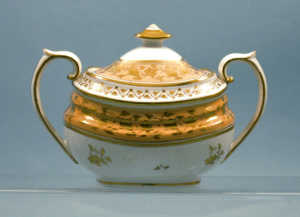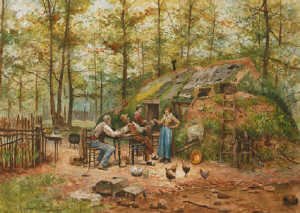We found 4178 price guide item(s) matching your search
There are 4178 lots that match your search criteria. Subscribe now to get instant access to the full price guide service.
Click here to subscribe- List
- Grid
Slavery. British Colonial Slavery, Compared with that of Pagan Antiquity, [by James Heywood Markland], pub. James Ridgway, 1830, vi, 65 pp, heavy spotting throughout, vertical fold crease, stictching broken and disbound without covers, 8vo A rare pro-slavery tract arguing that Caribbean slavery is very mild compared with that at the time of Christ, and which He did not condemn. Sabin 8096 & 81918. (1)
Three English underglaze blue transfer printed plates: Osterley Park pattern by Ridgway, with bowl indented centre, circa 1820; Camel pattern by Pountney & Goldney of Bristol, early 19th century; and a Wild Rose pattern example, also early 19th century, 27cm diameter and smaller; and a majolica glazed pedestal bowl, (4).
A Set of Five Ridgway Porcelain Dessert Plates, circa 1820], each of shaped circular form with five raised and moulded brackets and arches to the border picked out in blue, enclosing central bouquets and sprigs of flowers in vivid enamel colours within floral festoons in gilt, pattern No. 965 in red, 21.5cm diameter
Three Ridgway buff stoneware relief-moulded jugs: an Animal Hunting jug, height 12.2cm, unmarked; an Acorns and Berries jug, height 16.8cm, unmarked (tiny rim chip); and a 'Sylvan' jug, height 17.5cm, moulded registration diamond for 16 February 1849. See Henrywood 1/ 42 1/43 and 1/57 for these three designs
Four Ridgway relief-moulded jugs: a Pan jug in buff stoneware, height 22cm, unmarked; a Tam O'Shanter jug in buff stoneware, height 25.5cm, impressed 1835 publication mark (metal lid missing, handle riveted); an Eglinton jug in blue stoneware, height 24.9cm, impressed 1840 publication mark (crack); and a 'Sylvan' jug in white stoneware with a Britannia metal lid, overall height 20.6cm, moulded 1849 registration diamond (lid glued) See Henrywood 1/41 1/46, 1/51 and 1/57 for these designs
A John & William Ridgway Oxford and Cambridge College series dinner plate, printed in blue with 'Christ Church, Oxford' within the usual octagonal frame and border of flowers with goat and cherub vignettes, diameter 25cm, printed mark, circa 1820-30 (small chip behind rim) See Coysh & Henrywood 1 page 84 for a similar plate
Four blue-printed plates and a small dish: a 'Wild Rose' pattern tea plate, diameter 18.3cm, printed title mark; a William Ridgway & Co. 'Marmora' pattern dinner plate, diameter 26.2cm, printed mark; a William Adams & Sons 'Isola Belle' pattern dinner plate, diameter 23.8cm, printed mark; a soup plate with a typical later romantic scene, diameter 24.7cm, unmarked; and an 'Eton College' pattern small dish by G.F. Smith & Co, length 27.3cm, printed title mark with maker's initials; various dates circa 1830-70
A pair of unusual white stoneware oval baluster shaped jugs, each with dolphin loop handle and shell shaped covered rim, moulded in relief with putti, dolphins and shells, 6 1/4" high (16cm) circa 1850, and a Ridgway drabware two handled broth bowl, cover and stand, printed and painted with bands of flowers and leaves
A Ridgway plate, painted in coloured enamels with a church in a landscape, the green ground border decorated in yellow and gilt with flower and scrolling leaves, 9" diameter (23cm) pattern number 3554 in red, circa 1840, and another plate, painted with flowers, within a gilt diaper panelled border, circa 1850
Sixteen John Ridgway & Co dinner plates and seven soup plates, circa 1850, each decorated with the Westhead crest and motto 'Ora et Labora', within a scrolling gilt rim with angular cobalt banding against a shaded claret ground, marked in puce and 'Presented to J P Westhead Esq', 10.25" diameter (23).
AN EARLY 19TH-CENTURY BLUE TRANSFER-PRINTED JOHN & WILLIAM RIDGWAY "ANGUS SEATS" SERIES "RABY CASTLE, DURHAM" PATTERN ASHET, the re-entrant oblong field depicting a cowherd and beasts to the foreground, figures conversing on a path before the castle, the border having four landscape cartouches and wild flowers, unmarked, 49cm x 38.5cm, (19.3in x 15.1in) (cracked)*** See Coysh, A.W and Henrywood R.K., The Dictionary of Blue and White Printed Pottery, 1780-1880 - Vol I, p.314 for a matching ashet.
Slavery: A MID 19TH-CENTURY SAGE-GREEN STONEWARE MILK JUG moulded in relief with scenes from "Uncle Tom's Cabin", depicting, on one side, an auction of slaves and on the other a slave-master whipping a negro woman and her child, the handle modelled as a praying negro, tablet mark: Published by E. Ridgway & Abingdon, Hanley, June 1, 1853, 17.5cm, (6.9in) high
A Ridgway Porcelain Nine Piece Topographical Dessert Service, circa 1840, comprising lozenge cake dish, pair of square shallow serving dishes, and six circular dessert plates, each painted with different country landscapes mainly with towers, bridges and gothic ruins, as vignettes within rococo scroll and floral moulded borders enclosing three bouquets, pattern number 417/4, the lozenge dish 33.7cm wide (9)
A Pair of Coalport Porcelain Dessert Plates, circa 1825, of silver shape, gadrooned borders, painted with sprays of flowers in vivid enamel colours within gilt scroll framed midnight blue borders with fruiting vines and hops, 21.5cm diameter; and A Pair of Ridgway Porcelain Dessert Plates, of lobed circular shape, gadrooned borders, the central circular gilt scroll framed reserve painted with a bouquet and scattered sprigs in vivid enamel colours, within an olive green border with three encircling rows of eye motifs, acanthus pierced scroll and pierced handles, shape number "1174" in red enamel, 23cm diameter (2 pairs)
SINCLAIR George Hortus gramineus woburnensis: or, an account of the results of experiments on the produce and nutritive qualities of different grasses and other plants used as the food of the more valuable domestic animals: instituted by John, Duke of Bedford ... 3rd edition, 60 hand coloured plates, contemporary diced russia, a little rubbed and scuffed, some offsetting and spotting from the plates, 8vo., London: Ridgway, 1826. Note: Nissen 1850 Third edition, the first to contain the results of Sinclair's experiment, carried out with the assistance of Sir Humphry Davey, comparing the performance of different species and mixtures of grasses and herbs growing on different types of soil. Sinclair's experiment, performed during his tenure as head gardener for the Duke of Bedford at Woburn Abbey, showed that a greater diversity of grasses planted resulted in greater production of plant matter. It is now suggested that Sinclair's experiment provided the foundation of Darwin's "principle of divergence," a building block of his theory of evolution by natural selection. Sinclair's work at Woburn Abbey could be seen to represent one of the first ecological experiments.








![A Set of Five Ridgway Porcelain Dessert Plates, circa 1820], each of shaped circular form with five raised and moulded brac](http://lot-images.atgmedia.com/SR/10041/2349218/154-25-10041_468x382.jpg)


















